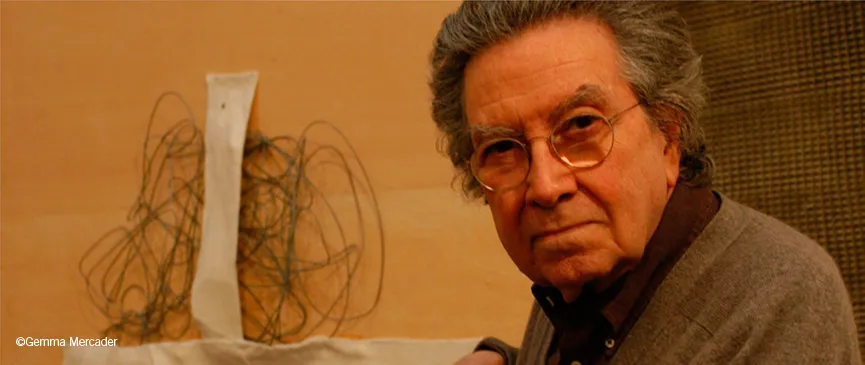Main content
Antoni Tàpies Prince of Asturias Award for the Arts 1990

Antoni Tàpies Antoni Tàpies (Barcelona, España, 1923 – 2012) took his first steps as an artist while convalescing from a serious illness. His growing dedication to drawing and painting led him to drop out of university. In the 1940’s, his works already showed a marked personality that stood out on the art scene of that time. In 1948, he co-founded the magazine “Dau al Set”. Influenced by Miró and Klee, he intensified the iconographic factor in his work. Little by little, he started to incorporate geometrical elements and studies of colour that were to awaken an interest for matter that took the form of canvases of intense texture and great expressive and communicative possibilities. With these works, Tapies was to achieve international recognition in the 1950’s. From the 1960’s onwards, he incorporated new iconographic elements (signs of writing, anthropomorphic elements, footprints and signs alluding to the reality of Catalonia) and technical procedures (new surfaces, the use of everyday objects and of varnish). Tàpies’ pictorial language has evolved since then, resulting in a diversified and prolific visual creativity admired worldwide.
He has shown at the MOMA and the Solomon R. Guggenheim Museum in New York, the Museum of Contemporary Art in Chicago, the ICA and Serpentine Gallery in London, the Kunsthaus in Zürich, the Musée d’Art Moderne, the Galerie Nationale du Jeu de Paume and the Georges Pompidou Centre in París, the Spanish Museum of Contemporary Art and the Queen Sofia Art Centre in Madrid, the Waddington Gallery in London, the Academia de España in Roma and the Guggenheim Museum in Berlin, among many others. The French National Library organised an exhibition of his work in 2001 and he staged a major show in Brazil in 2005. The Catalonian artist has a foundation in Barcelona that bears his name and which houses a collection of 2,300 paintings and sculptures as well as 3,100 drawings, etchings and lithographs. He presented some of his works at the 2010 Shanghai Universal Exhibition. Alongside his production of paintings and objects, Tàpies has been considerably active as a graphic artist, putting together a great number of folders and books in collaboration with poets and writers such as Alberti, Bonnefoy, Du Bouchet, Brodsky, Brossa, Daive, Dupin, Foix, Frémon, Gimferrer, Guillén, Jabès, Mestres Quadreny, Mitscherlich, Paz, Saramago, Takiguchi, Ullán, Valente and Zambrano, among others. Antonio Tàpies has simultaneously worked as an essayist, work which is reflected in a series of publications: “La práctica del arte” [The Practice of Art] (1971), “El arte contra la estética” [Art versus Aesthetics] (1977), “Memoria personal” [Personal Memories] (1983), “La realidad como arte. Por un arte moderno y progresista” [Reality as Art. For a Modern, Avant-garde Art] (1989), “El arte y sus lugares” [Art and its Places] (1999) and “Valor del arte” [The Value of Art] (2001).
With the transition to the 21st century, Tàpies continued to receive numerous awards, both nationally and internationally, with retrospective exhibitions of his work being held in the world’s leading museums and galleries. In 2003, on the occasion of his eightieth birthday, a retrospective comprising his best works was held at the Antoni Tàpies Foundation, with the public attending an open day. Similarly, a tribute to the artist was organized at the Barcelona Museum of Contemporary Art (MACBA) in 2004, with a major exhibition consisting of 150 works from the 1940s to the present, including paintings, sculptures, drawings and various creations by this great artist.
In 2010, the King granted him the title of Marquis of Tàpies. He is also a member of the Berlin Academy of Fine Arts (1982) and an Honorary Member of the Künstlerhaus of Vienna (1989), Honorary Member of the Academy of Fine Arts of San Fernando (1989) and of the French Academy of Fine Arts (1984) and Grand Officer of the Order of Santiago (1996), as well as holding several honorary doctorates. Among other distinctions, he holds the Gold Medal for Fine Arts (1981), the Praemium Imperale of Japan (1990), the French National Painting Prize (1985), the Herbert Boeckl Prize of Austria (1994), the National Etching and Graphic Art Prize (2002) and the Velázquez Visual Arts Prize (2003).
End of main content
